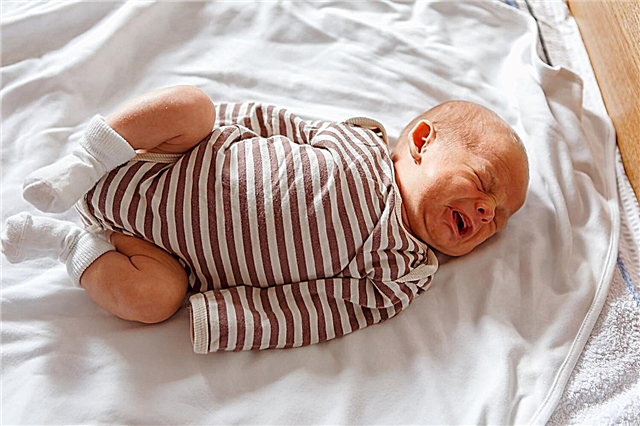Examples of potential conflicts
Of course, the ideal option is to avoid conflict situations altogether, but this is impossible and generally wrong. After all, the child lives in society, so collisions with other individuals are inevitable. It is only important to support the baby and show him the desired types of behavior.
 Thus, quarrels and even fights in playgrounds are quite common and to some extent natural phenomena. Let's analyze the 12 most common difficult situations and options for their most favorable resolution.
Thus, quarrels and even fights in playgrounds are quite common and to some extent natural phenomena. Let's analyze the 12 most common difficult situations and options for their most favorable resolution.
You are reprimanded
Imagine a situation when a child selflessly runs through snowdrifts, plays with a kitten or lies on the sand, while not disturbing anyone. However, the mother hears negative responses from all sides and direct statements about her parental incompetence.
Of course, any mother wants to immediately silence the "slanderers", rightly believing that no one gave strangers or strangers the right to criticize her educational principles. However, it is extremely difficult to get other people (who, of course, "better" know how to raise children) to shut up.
The ideal solution is to enable the "ignore" function, without paying any unreasonable quibbles and remarks. You can also say, “I listened to your opinion, it’s very nice to know that you care about raising my child. But I'll figure it out myself in this fascinating process. "
Remark to the child
 The next common situation is criticism of the baby. For example, a child enthusiastically swarms in the autumn foliage, simultaneously smearing himself in the mud. You do not consider such knowledge of the world to be something shameful, therefore, do not pull the little researcher.
The next common situation is criticism of the baby. For example, a child enthusiastically swarms in the autumn foliage, simultaneously smearing himself in the mud. You do not consider such knowledge of the world to be something shameful, therefore, do not pull the little researcher.
However, many well-wishers, especially the elderly, cannot pass by such a phenomenon and immediately begin to reprimand the baby that he looks like a pig, and his mom will now have to wash the whole suit and generally clean the whole apartment.
It is extremely important for the child to understand that the mother is always on his side. Therefore, criticism from a stranger is perceived extremely painfully, especially if parents are in no hurry to intercede for their child. As a result, he may have doubts about parental love.
The situation should be defused with an ordinary joke. Tell the ubiquitous neighbor that you walked perfectly, the baby really liked everything, and it's hard to imagine a walk without getting dirty, since a small child needs to carefully study the world around him. In addition, modern washing machines allow you to wash away any dirt without any problems.
Child returns his toy
Imagine the following situation: a child builds a snowman with a bucket or quietly rummages in the sand. His friend takes a bucket or scoop and starts playing himself. The offended kid gets angry, cries, tries to take his property by force.
It is necessary to understand that the child has the right to react violently to “property” encroachment from other kids. At an early age, the crumbs still do not understand that objects are taken temporarily, moreover, while the ability to share is not on the list of children's virtues.
You should not focus on the negative actions of your child. The task of the parent is to make it clear to the child that it is necessary to solve the problem not with the help of fists, but with words. That is, the most important thing is to teach how to negotiate with another child.
What to do?
The sequence of actions can be as follows:
- If children fight, separate them quickly.
- Explain that you understand your child's desire not to give up his own toy.
- Tell us about the wishes of the second child: “Pete likes your little scoop, he wanted to play with it. Let's give the scoop back for a little while, and he will give you a typewriter for a while. "
- If Petya agreed, encourage your child to swap toys. Usually children agree, especially if given a choice (several cars).
- Your child flatly refuses to give the scoop? You should not scold him, call him a greedy person, and even more so take the toy by force. Apologize to the second child and allow your toddler to keep playing.
You need to react by looking at the situation. If the children are already starting to "roll up their sleeves" for a fight, you should either divert attention ("Look which kitty ran"), or simply take your child to another corner of the sandbox.
The kid is crying, unable to return his toy
Another situation related to toys: the baby cries when his doll or car is taken away. Of course, not all children are capable of taking their property from the enemy. Some immediately run to their mother with tears and ask to punish the offender. The problem, of course, is not the most fatal, but the child rightly hopes for parental support.
What to do?
The most important thing is not to dismiss the child's tears as he is waiting for your protection. First, you need to ask the other kid together to return the toy to your son or daughter. This must be done as politely as possible, without scolding the "bully". Alternatively, invite the children to swap toys.
 If the children are stubborn and the conflict cannot be resolved with the help of persuasion, feel free to side with your child and very gently take his doll or scoop from another baby. You can ask his mother to do it.
If the children are stubborn and the conflict cannot be resolved with the help of persuasion, feel free to side with your child and very gently take his doll or scoop from another baby. You can ask his mother to do it.
The child takes someone else's toy
The curiosity of children knows no bounds, so sooner or later all kids come across other people's toys that lie derelict. And if everything is clear with other children, then what to do if it is your child who takes other people's dolls, cars or little shovels? It is necessary to understand the situation.
What to do?
The solution to the problem depends largely on whether the owner of the toy is known.
- if the doll belongs to a well-known child, you need to agree with him and his mother, giving something in return. Usually, in such cases, conflict situations do not arise at all. Just do not forget to return the toy to the owner afterwards;
- if the owner is not known, you can ask others out loud. The question remained unanswered? Explain to your child that it is strictly forbidden to take other people's things without permission. After that, distract the baby to another object or object.
 If the child still cannot leave the found toy, try to go in search of the owner together. During this time, you will find the owner, and the baby will have time to play with a doll or a car. But in any case, after the game, the find should be left in place, so that later you will not be accused of embezzling someone else's property.
If the child still cannot leave the found toy, try to go in search of the owner together. During this time, you will find the owner, and the baby will have time to play with a doll or a car. But in any case, after the game, the find should be left in place, so that later you will not be accused of embezzling someone else's property.
The child takes away someone else's toy
Now your child is acting as an aggressor who takes someone else's property from another child. Your task, as a parent, in this situation is to teach your child to respect other people's property. Understanding the boundaries "mine - someone else's" will allow you to quickly understand the limits of your own "I".
What to do?
Explain to your child that you understand his desire to play with the bucket, but it belongs to another kid, so you need to ask his permission: “Let's ask Misha to play him with the bucket later, and now let's go ride the carousel.” Most likely, in half an hour this situation will be resolved to everyone's pleasure.
 Another way to resolve the conflict is to invite children to swap toys for a while. If the second child doesn't mind playing with the toy car for a while, invite him to choose any toy car. Then the children do the reverse exchange.
Another way to resolve the conflict is to invite children to swap toys for a while. If the second child doesn't mind playing with the toy car for a while, invite him to choose any toy car. Then the children do the reverse exchange.
The child is the first to swing on the swing
Let's imagine a picture: your child is sitting on a swing. Suddenly, a neighbor's kid comes up and takes aim at the same sports equipment. Of course, the rule of sequence should apply here, that is, the second child must wait, but it is important to remind your son or daughter of this, who "occupied" the swing.
What to do?
If a queue begins to form near the swing, it is necessary to prepare your child for the fact that he will soon have to get off his familiar place. The conversation can be like this: "You see, the boy also decided to swing, let's swing a little more and go to the ice slide."
What to do if your child categorically does not want to get off the swing? It is necessary either to offer the waiting baby some alternative (“Let the boy play with your typewriter for now”) or “remember” that some cartoon is waiting for him at home.
The child wants to swing, but the swing is busy
The opposite situation - your child wants to swing on a swing, but at this moment another baby is on them, who also does not want to get off this device and in every possible way demonstrates that you will not wait for your turn for a long time.
What to do?
You should try one of the following options:
- draw your child's attention to other activities - playing in the sandbox, descending a slide, etc.;
- ask the rocking child to give up the carousel (this, of course, needs to be done very politely);
- Offer the swinging child an equal exchange - while you swing, he can play with your child's toy car.
If you know the rocking toddler well, the matter is greatly simplified. It is likely that a simple request would be sufficient for him to yield to the swing. However, it should be remembered that he is not obliged, after the first word, to abandon an interesting occupation for the sake of other people.
The kid is not able to protect himself
Another unpleasant situation - another baby approaches the child and starts pushing, hitting or screaming. Your child does not understand how to behave in this case. At the same time, no one talks about the baby's weakness or tearfulness.
The main goal of all your future actions is to teach your child to stand up for themselves. At the same time, you need to show the baby that no one ever dares to humiliate and offend him. This can be done using a simple sequence of actions.
What to do?
First of all, you should try to prevent an offensive blow if you notice a hand swing. However, if the shock has already occurred, you need to:
- be sure to calm your child down to avoid fear or tears;
- try to explain the reason for the act of someone else's kid (“Perhaps he just wanted to invite you to the game, but did not understand how to say it”);
- the little bully also needs to be explained that hitting your child is strictly prohibited.
In no case should you physically influence someone else's child, even if he hit your baby. The parents of the offender can perceive any action on your part as violence, which ultimately will result in very unpleasant consequences.
The child gives change
It's one thing if the kid is silent and does not know what to do if he is beaten. Another thing is when the child responds to the aggressor, and even so that he runs to his mother for help. Of course, you can understand such emotionality, since children do not yet know how to solve a problem without fists.
What to do?
Action options:
- just tell both fighters that it is forbidden to fight;
- tell you how to behave correctly, for example, negotiate, exchange toys, etc.;
- returning home, you need to replay the situation, bringing to the child the idea that the reasonable limits of "self-defense" cannot be exceeded.
 Of course, it is best to avoid fights and resolve the disputes and conflicts that arise through reasonable negotiations. But in any case, you need to breed fighters in different corners and only then find out who is right and who is wrong. Ugly childish fights are not the best outcome of a walk.
Of course, it is best to avoid fights and resolve the disputes and conflicts that arise through reasonable negotiations. But in any case, you need to breed fighters in different corners and only then find out who is right and who is wrong. Ugly childish fights are not the best outcome of a walk.
A toddler offends another child
 The option is not excluded when it is your child who acts as an aggressor, fighter and abuser. It is likely that the reason for this behavior lies in the inability to interact with peers, the desire to attract the attention of parents.
The option is not excluded when it is your child who acts as an aggressor, fighter and abuser. It is likely that the reason for this behavior lies in the inability to interact with peers, the desire to attract the attention of parents.
To exclude the formation of an aggressive style of behavior, psychologists advise always to react in the same way to such actions of the baby. The parent's task is to teach him to control his emotions and adequately express negative feelings.
What to do?
It is important to pay attention to both the victim and the "tormentor":
- first of all, contact the victim, apologizing for your own child;
- explain to your baby that you cannot do this, and also try to correct the situation (shake off the crumbs, stroke the victim);
- Try to involve the children in an activity, for example, invite them to build a sand castle together.
In the case of child aggression, role-playing games and playing a situation with dolls help well. In an unobtrusive way, you can teach your child to talk about their negative feelings. In addition, in the game, you can splash out emotions by stomping, beating pillows, throwing paper balls, etc.
Kids sort things out
On the playground, there is often a showdown between children. Moreover, it is often quite equal rivalry. Kids are trying to figure out which of them is stronger or more skillful. If there is no fight, no one is trying to hit or bite the opponent, and you should not intervene in the conflict at all.
It's another matter if the situation starts to escalate.
What to do?
If the quarrel has gained momentum, you should:
- switch attention to yourself;
- offer to look at each other;
- describe your emotions (“I love it when you are friends and play”);
- talk about the following actions ("What will you do? What are you doing?");
- suggest any common activity;
- during a conflict, the child is in an agitated state and does not perceive information. But at home, in a calm atmosphere, the baby will take your "moral teachings" with great attention. Only this should be done in a confidential and relaxed manner: heart-to-heart conversations with the child, conversations based on plot pictures, stories about your childhood, role-playing games, dramatizations, reading works of art, etc.
Of course, you need to act according to the circumstances. It is possible (and even very likely) that another parent will intervene in the conflict. It is important not to slip into a banal scandal, but by joint efforts try to resolve the emerging quarrel.
As a conclusion
It should be understood that the child does not yet own social tools, so the task of the parents is to teach the baby the desired behavioral models. And only then the kid will begin to solve conflicts on his own based on the available knowledge.
At the same time, it is worth remembering that you cannot give your child an offense to other children and adults. It is to you that he comes for support, so you should not deceive his expectations. However, you should not also shield the baby if he acts as an aggressor.



